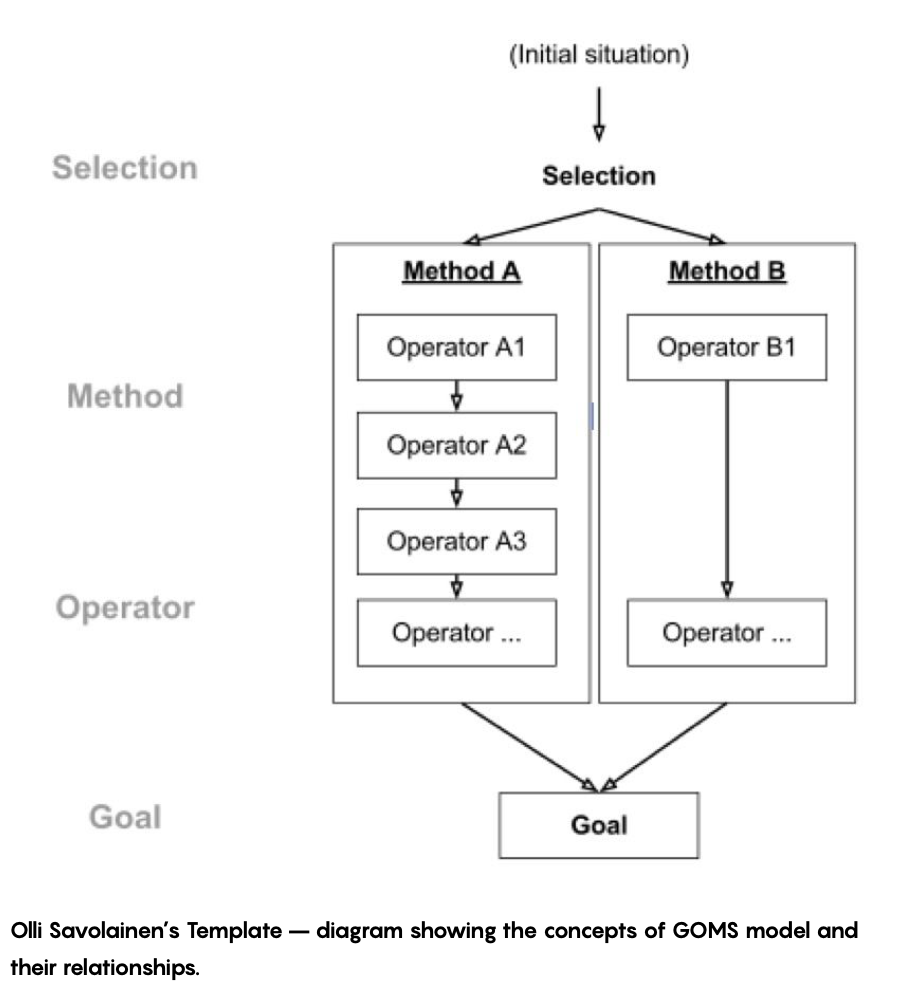GOMS
| Number of Participants | Facilitators | Category | Duration | Level of Difficulty |
| Depends On the Case | Optional | Ideate & Test Phase | Depends on The Case | Moderate |


Description
GOMS is a model of task analysis and human performance. It can be used to improve human-computer interaction efficiency by eliminating useless or unnecessary interactions (time and cost-saving). The method was introduced by Stuart K. Card, Thomas P. Moran and Allen Newell in their book The Psychology of Human Computer Interaction written in 1983. Since then, GOMS has been one of the most widely known theoretical concepts in HCI (eg. real-world design, engineering models, evaluation tasks, etc. It is also widely used by usability specialists for computer system design because it produces quantitative and qualitative predictions of how users will use a proposed system. GOMS is an abbreviation from:
G → Goals : are what the user has to accomplish. Goals are often broken down into subgoals; all of the subgoals must be accomplished in order to achieve the overall goals.
O → Operators: are all actions needed to achieve the goals. Operators can be perceptual, cognitive, or motor acts, or a composite of these.
M → Methods: are sequences of operators and subgoal invocations that accomplish a goal. If the goals have a hierarchical form, then there is a corresponding hierarchy of methods.
S → Selection: There is often more than one method to accomplish a goal. In this case, selection rules are necessary to represent the user’s knowledge of which method should be applied.
A simple example of GOMS method:
Goals: Send an email.
Kate Dam’s Template
Operators: Amount of mouse clicks to send email.
Methods: Move mouse to send button and click it.
Selection: Method 1; Method 2 (Move mouse to send button and press enter.
Variations of GOMS methods
Basically there are four different GOMS techniques: the Keystroke- Level Model (KLM),
CMN-GOMS, NGOMSL, and CPM-GOMS. Each model has a different complexity and varies in activities. For all of the variants, the definitions of the major concepts are the same. Among these GOMS models, Keystroke- Level Model (KLM) is the simplest and most popular one, in which we can empirically check the values for operators like button presses, clicks, pointer movement time, etc… The other three major GOMS variants (CMN-GOMS, NGOMSL, and CPM-GOMS) require extensive training and familiarity with Human-Computer Interaction principles to perform an analysis.
Materials & Preparation
Depending on the task.
Step-by-Step Instructions
- Decide on the template
- Kate Dam’s Template or
- Olli Savolainen’s diagram

Remarks, Tips, Limitations
Benefits
GOMS is a task analysis method that can accurately measure human-performance (especially in HCI), and allows the visibility of all procedural knowledge. With GOMS, an analyst can easily estimate a particular interaction and calculate it quickly and easily, thus, allows them to determine the amount, consistency, and efficiency of the procedures that users must follow. Since the usability of many systems depends heavily on the simplicity and efficiency of the procedures, the GOMS models have considerable value in guiding interface design. Therefore, GOMS is not just a research approach, but is applicable in the real world of computer, software and system development. Research has shown that GOMS can be useful when other evaluation techniques might not be practical. GOMS is also proven to be time- and cost-effective.
Limitations
However, in HCI’s field, the application of GOMS requires extensive training and familiarity with Human-Computer Interaction principles to perform an analysis. Other disadvantages of GOMS are that:
- GOMS only addresses the usability of a task on a system, not its functionality.
- Mental workload is not addressed in the model, making this an unpredictable variable.
- User personalities, habits or physical restrictions (e.g. disabilities) are not accounted for in any of the GOMS models. All users are assumed to be exactly the same.
Referances
John, B. E., & Kieras, D. E. (1996). Using GOMS for user interface design and evaluation: Which technique?. ACM Transactions on Computer-Human Interaction (TOCHI), 3(4), 287-319.
John, B. E., & Kieras, D. E. (1996). The GOMS family of user interface analysis techniques: Comparison and contrast. ACM Transactions on Computer-Human Interaction (TOCHI), 3(4), 320-351.
Kieras, D. E. (1999). A guide to GOMS model usability evaluation using GOMS and GLEAN3. University of Michigan, 313. Retrieved 27.08.2020, from https://en.m.wikipedia.org/wiki/GOMS
Costin Pribeano, Georgios Christou, Ben Werner (December 2009). GOMS. Retrieved 27.08.2020, from https://www.usabilitybok.org/goms
Kate Dam (06.08.2019). What is GOMS? How could it help you to increase usability in the system. Retrieved 27.08.2020, from
https://uxplanet.org/what-is-goms-how-could-it-help-you-to-increase-usability-in-the-system-732655ab777b?gi=ac338dfeb9a2
Contributed by Cam Van Tran Thi.


